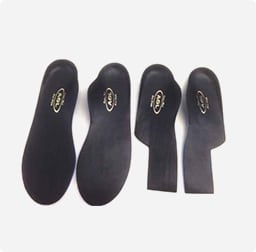What is an Orthotic?

An orthotic has many descriptions:
- An external mechanical restraining device
- A realigning device
- A device that restores the natural shock absorbing qualities of the foot.
All are correct. But let’s keep it simple: The objective of orthotics is to change the ground on which a patient’s walks to help fix their condition by correcting gait and posture.
Like prescription glasses, orthotics are similar – they act as the corrective medium between the ground and the feet, just as the lenses in glasses are designed to correct specific types of vision. Also like glasses, it is crucial that orthotics are worn every day – they are not short-term fix. We believe that orthotics work by correcting the foundation of the body.
They act like a “flow of correction” going through the human system, like water travelling through a hose. If the water travelling through a hose hits a kink, then the water cannot get through, so this causes back-pressure to the tap. The human body is the same – if the flow hits a tight, scarred or arthritic area there will be ‘back’ pressure.
Orthotics cannot work alone. A combination of different treatment modalities is important to correct the patient’s biomechanical anomalies. This is why we use specific treatment techniques (see below) to assist us providing the best long term treatment for the patients.

Two different orthotic styles
Orthotic styles
There are about 28 orthotic styles which can have up to 150 modifications made to suit individual needs.
Ultimately the orthotic design depends on the assessment and how the practitioner takes the cast of the foot, with many doing this while the patient is sitting or lying down.
At Dr. Abbie Clinics we have a different approach. We take the cast while the patient is standing, with either semi weight or full weight on the foot, which is the natural load bearing position.
Here we think like engineers, who take gravitational and ground reaction forces very seriously.
Measuring foot and alignment
A good cast or scan must capture the X,Y,Z axis’ of the foot in a neutral position, where it is neither pronating (rolling in) or supinating (rolling out). To ensure this position is correct we use the unique Anterior Line Method (ALM) – designed by Dr Abbie Najjarine – when taking an impression cast or running a 3D computer scan of the foot. By applying these techniques we can be sure we have all the correct dimensions to work with in order to treat the condition.


